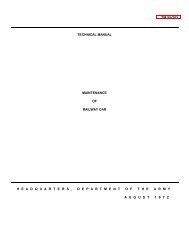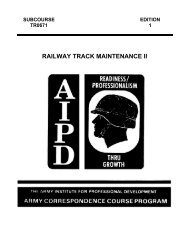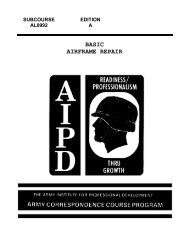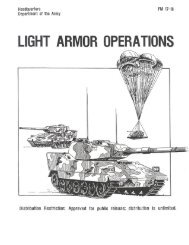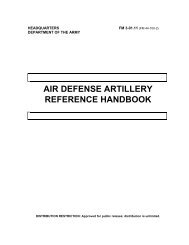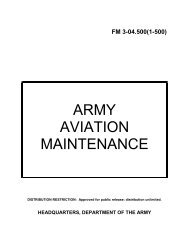fm 44-100 us army air and missile defense operations
fm 44-100 us army air and missile defense operations
fm 44-100 us army air and missile defense operations
You also want an ePaper? Increase the reach of your titles
YUMPU automatically turns print PDFs into web optimized ePapers that Google loves.
FM<strong>44</strong>-<strong>100</strong><br />
COMMANDER<br />
5-6<br />
5-27. The comm<strong>and</strong>er is the key to concept formulation, planning, <strong>and</strong><br />
executing at each level of comm<strong>and</strong>. The comm<strong>and</strong>er's personal responsibility<br />
is formulating a single unifying vision <strong>and</strong> expressing it in the comm<strong>and</strong>er’s<br />
intent. Comm<strong>and</strong>ers m<strong>us</strong>t underst<strong>and</strong> the intent of the comm<strong>and</strong>er two<br />
levels up <strong>and</strong> underst<strong>and</strong> the intent <strong>and</strong> concept of operation of the<br />
immediate senior comm<strong>and</strong>er. Comm<strong>and</strong>ers m<strong>us</strong>t also underst<strong>and</strong> the battle<br />
from the perspective of adjacent units <strong>and</strong> subordinate comm<strong>and</strong>ers who<br />
m<strong>us</strong>t execute the decisions. The comm<strong>and</strong>er's estimate <strong>and</strong> assessment<br />
process helps decide how to accomplish the assigned mission.<br />
5-28. Comm<strong>and</strong>ers m<strong>us</strong>t determine <strong>and</strong> specify the comm<strong>and</strong>er's critical<br />
information requirements (CCIR) that are needed to underst<strong>and</strong> the<br />
battlefield <strong>and</strong> the flow of <strong>operations</strong>. CCIR consists of three types of<br />
information: priority intelligence requirements (PIR), friendly force<br />
information requirements (FFIR), <strong>and</strong> essential elements of friendly<br />
information (EEFI). The comm<strong>and</strong>er m<strong>us</strong>t foc<strong>us</strong> the organization <strong>and</strong> battle<br />
comm<strong>and</strong> systems to give the information needed to conduct the estimate <strong>and</strong><br />
refine the assessment driven by time or event. The comm<strong>and</strong>er m<strong>us</strong>t,<br />
however, still be prepared to make decisions <strong>and</strong> accept risk without<br />
complete information, recognizing that waiting for complete information may<br />
result in lost opportunities to act. Too much information can paralyze a force<br />
as quickly as too little data if the comm<strong>and</strong>er is hesitant to act in ambiguo<strong>us</strong><br />
situations. The comm<strong>and</strong>er m<strong>us</strong>t tell the staff what information is important<br />
to collect. Whatever factors are present, the comm<strong>and</strong>er is personally<br />
responsible for establishment of the comm<strong>and</strong>er's critical information<br />
requirements.<br />
5-29. Once the comm<strong>and</strong>er has the necessary information, he m<strong>us</strong>t possess<br />
the creativity <strong>and</strong> intuition to visualize the flow of events toward a future<br />
state. The comm<strong>and</strong>er formulates a concise expression of how elements of the<br />
comm<strong>and</strong> will operate together to accomplish their operational<br />
responsibilities <strong>and</strong> missions.<br />
5-30. Comm<strong>and</strong>ers m<strong>us</strong>t be able to convey to subordinates a clear, concise<br />
statement of the comm<strong>and</strong>er’s intent for future <strong>operations</strong>, which includes<br />
the purpose; what tasks <strong>and</strong> when they want those tasks accomplished; <strong>and</strong><br />
the desired end-state. Their concept of the operation m<strong>us</strong>t include an overall<br />
scheme of <strong>operations</strong>, the necessary interfaces <strong>and</strong> coordination, the sequence<br />
from one phase to another, <strong>and</strong> the priorities <strong>and</strong> risks the comm<strong>and</strong>er is<br />
willing to take. Connectivity m<strong>us</strong>t exist between current <strong>operations</strong> <strong>and</strong> the<br />
branches <strong>and</strong> sequels of the future plan. While a portion of this future state<br />
may be directed by a higher level comm<strong>and</strong>er's intent, the comm<strong>and</strong>er m<strong>us</strong>t<br />
possess the ability to envision the organization's future state within its battle<br />
space.<br />
5-31. Techniques <strong>and</strong> procedures may vary, but planning <strong>and</strong> executing<br />
<strong>operations</strong> are continuo<strong>us</strong> <strong>and</strong> concurrent activities. Comm<strong>and</strong>ers m<strong>us</strong>t<br />
master time-space-resource-purpose relationships <strong>and</strong> underst<strong>and</strong> the ways<br />
they affect friendly <strong>and</strong> enemy capabilities to achieve success in battle. They<br />
m<strong>us</strong>t be able to orchestrate all functions affecting their battle space:<br />
intelligence, fires, forces positioning, resources, deception, <strong>and</strong> timing. In




